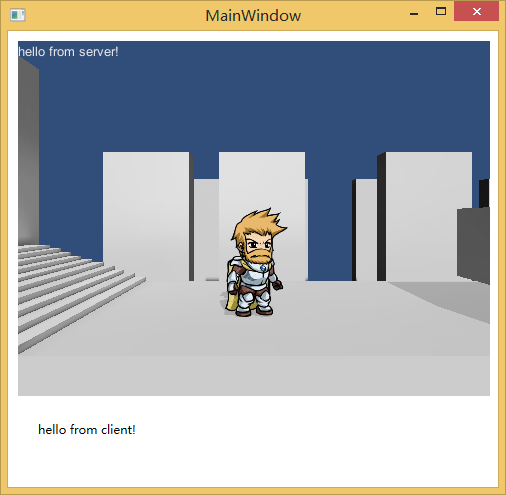博客原文:http://www.lolofinil.com/2014/10/10/wpf-unity-embed-pipes/
说明需求是这样的 —— 一个编辑器。既能够方便得编辑各种静态数据表(Excel),又能够对表中指定的资源进行预览(Spine骨骼动画)。 问题在于适合做表编辑器的软件框架,如WPF、Winform等等,都没有相应的Spine渲染库;而支持Spine渲染的框架,如Unity3D、MonoGame、Cocos2D等,又或存在Excel库不好用或者缺少软件向控件的问题。 我们采取的方案是,使用WPF做它擅长的软件功能,而使用Unity作为“渲染控件”。 技术路线为什么不用WPF嵌入UnityWebPlayer?
将Unity嵌入WPF(或Winform),比较常见的做法是通过ActiveX将UnityWebPlayer包装成一个真正的控件。但由于UnityWebPlayer运行在安全沙箱中,它至少有以下两个问题: - 没有System.IO的程序集,只能够加载assetbundle,无法加载未经管线预处理的Spine
- 没法加载Excel文件
- 如何将Unity Windows Standalone 嵌入WPF
将Standalone作为一个控件,指定到WPF父窗口下。采用WindowsAPI来实现。
如何实现Standalone与WPF双向通信
需要能在WPF中设定Standalone的当前Spine,也要能在Standalone上操作由WPF维护的Excel。一个可行的方案是pipes。
这篇讨论中说Unity不初始化NamedPipelineServer。那么就拿它当NamedPipelineClient好了。 将Unity Windows Standalone 嵌入WPF核心代码如下:
// 定义一个WPF用户控件,来定义Standalone的尺寸
ProcessStartInfo info = new ProcessStartInfo(“UnityControl.exe”);
info.UseShellExecute = true;
info.WindowStyle = ProcessWindowStyle.Minimized;
m_AppProcess = System.Diagnostics.Process.Start(info);
m_AppProcess.WaitForInputIdle();
this.Dispatcher.BeginInvoke(
System.Windows.Threading.DispatcherPriority.ApplicationIdle,
appIdleEvent, this, null); // Application Idle 事件处理WindowInteropHelper helper = new WindowInteropHelper(Window.GetWindow(this));IntPtr ptr = helper.Handle;SetParent(app.MainWindowHandle, helper.Handle);SetWindowLong(new HandleRef(this, app.MainWindowHandle), GWL_STYLE, WS_VISIBLE);MoveWindow(app.MainWindowHandle, (int)control.Margin.Left, (int)control.Margin.Top, (int)control.Width, (int)control.Height, true);实现Unity Windows Standalone与WPF通讯// WPFNamedPipeServerStream pipeServer = new NamedPipeServerStream( "testpipe", PipeDirection.InOut, 1);pipeServer.WaitForConnection();string str = "hello from server!";byte[] outBuffer = Encoding.Unicode.GetBytes(str);int len = outBuffer.Length;pipeServer.WriteByte((byte)(len / 256));pipeServer.WriteByte((byte)(len % 256));pipeServer.Write(outBuffer, 0, len);pipeServer.Flush();len = pipeServer.ReadByte() * 256;len += pipeServer.ReadByte();byte[] inBuffer = new byte[len];pipeServer.Read(inBuffer, 0, len);string remoteInfo = Encoding.Unicode.GetString(inBuffer);lbRemoteInfo.Content = remoteInfo;// Unity pipeClient = new NamedPipeClientStream( ".", "testpipe", PipeDirection.InOut);pipeClient.Connect(10000);int len = pipeClient.ReadByte() * 256;len += pipeClient.ReadByte();byte[] inBuffer = new byte[len];pipeClient.Read(inBuffer, 0, len);remoteInfo = Encoding.Unicode.GetString(inBuffer);pipeClient.Flush();string str = "hello from client!";byte[] outBuffer = Encoding.Unicode.GetBytes(str);len = outBuffer.Length;pipeClient.WriteByte((byte)(len / 256));pipeClient.WriteByte((byte)(len % 256));pipeClient.Write(outBuffer, 0, len);pipeClient.Flush();效果做了一个简单的测试,看上去效果不错: - Unity(Client)被嵌入WPF(Server)窗口
- WPF向Unity发送一条”hello from server!”,在Unity控件的左上角显示
- Unity向WPF发送一条”hello from client!”,显示在一个WPF的Label上
说明和参考MSDN管道通讯Demo
[url=http://msdn.microsoft.com/zh-cn/library/bb546085.aspx]如何:使用命名管道进行网络进程间通信 Mono不支持管道安全级别
不用就可以了,NamedPipeServerStream构造函数里,不要填TokenImpersonationLevel
StackOverflow 在Unity中启用System.IO.Pipes命名空间
在Player Settings中,将.net版本设置为.net2.0,默认是.net2.0 subset
StackOverflow
| 
